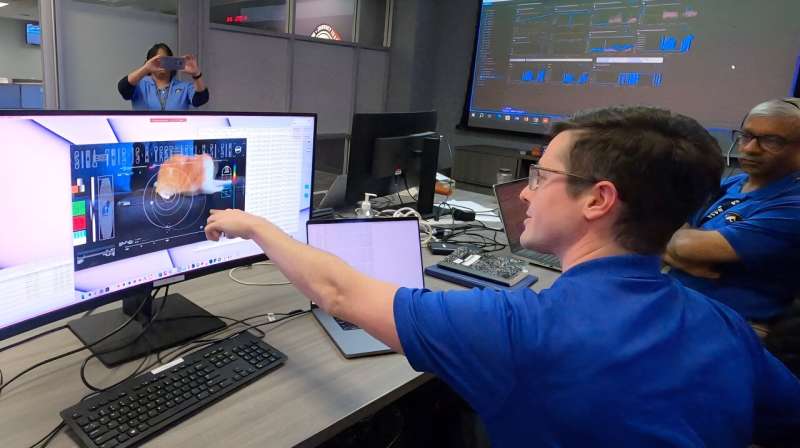This article has been reviewed according to Science X's editorial process and policies. Editors have highlighted the following attributes while ensuring the content's credibility:
fact-checked
trusted source
proofread
NASA's tech demo streams first video from deep space via laser

NASA's Deep Space Optical Communications experiment beamed an ultra-high definition streaming video on Dec. 11 from a record-setting 19 million miles away (31 million kilometers, or about 80 times the Earth-moon distance). The milestone is part of a NASA technology demonstration aimed at streaming very high-bandwidth video and other data from deep space—enabling future human missions beyond Earth orbit.
"This accomplishment underscores our commitment to advancing optical communications as a key element to meeting our future data transmission needs," said NASA Deputy Administrator Pam Melroy. "Increasing our bandwidth is essential to achieving our future exploration and science goals, and we look forward to the continued advancement of this technology and the transformation of how we communicate during future interplanetary missions."
The demo transmitted the 15-second test video via a cutting-edge instrument called a flight laser transceiver. The video signal took 101 seconds to reach Earth, sent at the system's maximum bit rate of 267 megabits per second (Mbps). Capable of sending and receiving near-infrared signals, the instrument beamed an encoded near-infrared laser to the Hale Telescope at Caltech's Palomar Observatory in San Diego County, California, where it was downloaded. Each frame from the looping video was then sent "live" to NASA's Jet Propulsion Laboratory in Southern California, where the video was played in real time.
The laser communications demo, which launched with NASA's Psyche mission on Oct. 13, is designed to transmit data from deep space at rates 10 to 100 times greater than the state-of-the-art radio frequency systems used by deep space missions today. As Psyche travels to the main asteroid belt between Mars and Jupiter, the technology demonstration will send high-data-rate signals as far out as the Red Planet's greatest distance from Earth. In doing so, it paves the way for higher-data-rate communications capable of sending complex scientific information, high-definition imagery, and video in support of humanity's next giant leap: sending humans to Mars.
"One of the goals is to demonstrate the ability to transmit broadband video across millions of miles. Nothing on Psyche generates video data, so we usually send packets of randomly generated test data," said Bill Klipstein, the tech demo's project manager at JPL. "But to make this significant event more memorable, we decided to work with designers at JPL to create a fun video, which captures the essence of the demo as part of the Psyche mission."
Feline frequency
Uploaded before launch, the short ultra-high definition video features an orange tabby cat named Taters, the pet of a JPL employee, chasing a laser pointer, with overlayed graphics. The graphics illustrate several features from the tech demo, such as Psyche's orbital path, Palomar's telescope dome, and technical information about the laser and its data bit rate. Tater's heart rate, color, and breed are also on display.
"Despite transmitting from millions of miles away, it was able to send the video faster than most broadband internet connections," said Ryan Rogalin, the project's receiver electronics lead at JPL. "In fact, after receiving the video at Palomar, it was sent to JPL over the internet, and that connection was slower than the signal coming from deep space. JPL's DesignLab did an amazing job helping us showcase this technology—everyone loves Taters."
There's also a historical link: Beginning in 1928, a small statue of the popular cartoon character Felix the Cat was featured in television test broadcast transmissions. Today, cat videos and memes are some of the most popular content online.
Milestone after milestone
This latest milestone comes after "first light" was achieved on Nov. 14. Since then, the system has demonstrated faster data downlink speeds and increased pointing accuracy during its weekly checkouts. On the night of Dec. 4, the project demonstrated downlink bit rates of 62.5 Mbps, 100 Mbps, and 267 Mbps, which is comparable to broadband internet download speeds. The team was able to download a total of 1.3 terabits of data during that time. As a comparison, NASA's Magellan mission to Venus downlinked 1.2 terabits during its entire mission from 1990 to 1994.
"When we achieved first light, we were excited, but also cautious. This is a new technology, and we are experimenting with how it works," said Ken Andrews, project flight operations lead at JPL. "But now, with the help of our Psyche colleagues, we are getting used to working with the system and can lock onto the spacecraft and ground terminals for longer than we could previously. We are learning something new during each checkout."




















